Day 3 of a 3-day Autumn Migration & Wader Spectacular tour and it was the day for the Wader Spectacular this morning. After a slightly misty start, it was a mostly cloudy morning. The cloud thickened early afternoon and we had half an hour or so of light rain before it cleared through.
It was an early start to get up to Snettisham ahead of the tide. When we arrived out on the seawall, there was still a lot of exposed mud in front of us. A massive line of Knot was strewn across the mud, very well camouflaged in the misty early morning light, before they took off and flew off low to land again higher up.
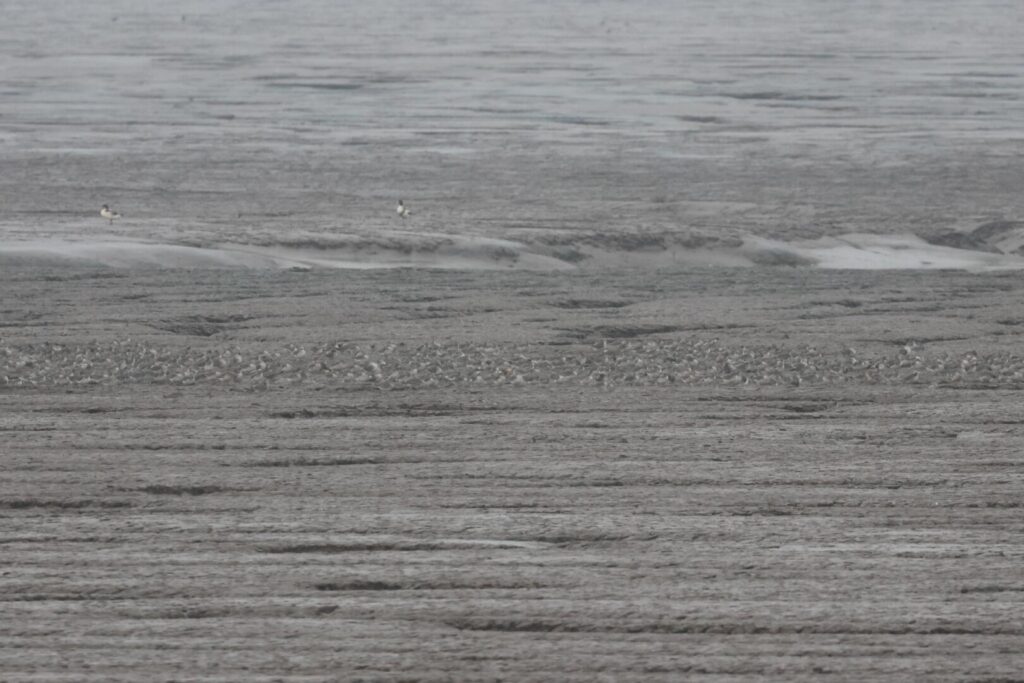
A group of Oystercatchers had gathered up by the sailing club as usual but most this morning were already standing out on the drier mud over towards the edge of the saltmarsh. After a while, the few that were off to our right took off and flew past, flashing white as they caught the low sunlight from behind us. They landed up with the others.
There were a few other waders out on the mud here, but not so many small ones today. We could see a large gathering of Bar-tailed Godwits further out, on the edge of the water. A Spotted Redshank appeared with the Common Redshanks, feeding in the small pools. There were a few Ringed Plover and Sanderling scurrying around on the mud.
We had seen a few Pink-footed Geese flying inland on our way down to the Wash. Now, we picked up some small groups coming up off the mud out in the mist. They roost out on the Wash. The Pinkfeet didn’t come in over the seawall though, and disappeared off north.

An adult Mediterranean Gull flew in off the mud and past in front of us, flashing its white wing tips. It was followed by a succession of more Mediterranean Gulls, all winter adults, which flew off along the coast to the north. We could see some flocks of Knot whirling round in the distance, out in the mist. Something had obviously put them up, and two Marsh Harriers now flew in across the mud towards us.
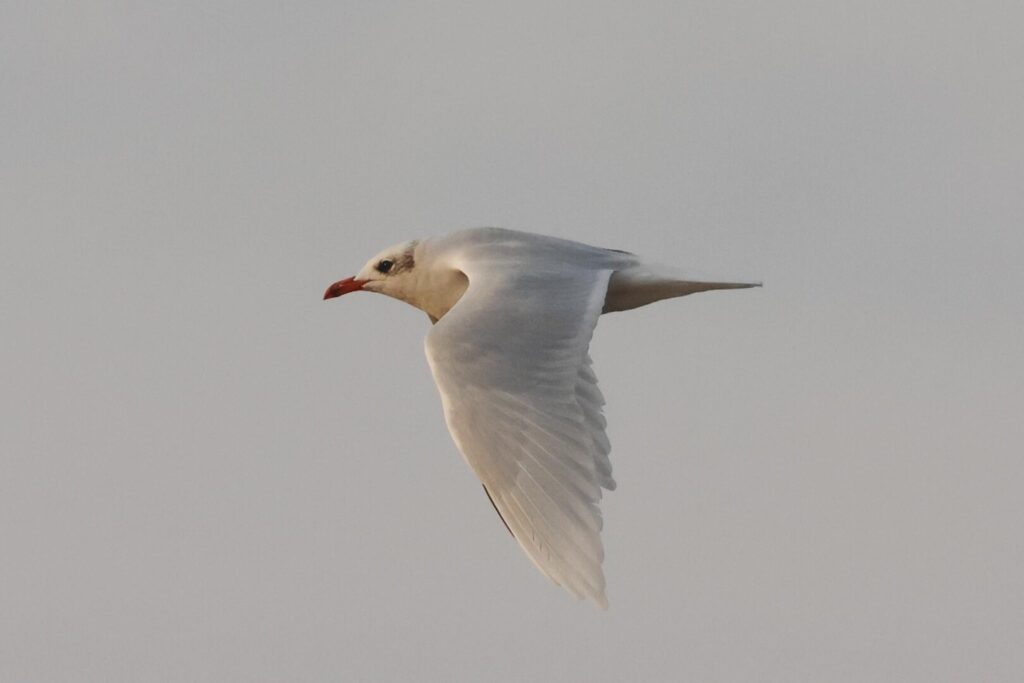
Very quickly, the tide line was past us, so we continued on down to Rotary Hide where we stopped to scan again. The water had caught up with some of the Oystercatchers which were now marching away from the tide to the drier ground further up. We stopped to watch them – to the naked eye, it looked like the whole black flock was flowing across the mud.

The Knot gathered just behind had a different reaction to the rapidly rising tide. As the water caught up with the ones on the edge, they took off and flew over the top of the others still on drier mud, landing again on the other end of the flock.
The tide was coming in fast, so we continued down. We stopped to watch the Oystercatchers again, getting pushed towards the last corner of the mud over by the saltmarsh. They were starting to get packed tighter together and before we got to the end, already peeling off in waves. Flying up piping noisily and over our heads, dropping down onto the Pit behind.
We had only just got ourselves into position when something spooked the Knot and they erupted into the air, just as they were squashed into the last corner of the mud. There were probably around 70,000 of them here today, and they blackened the sky.
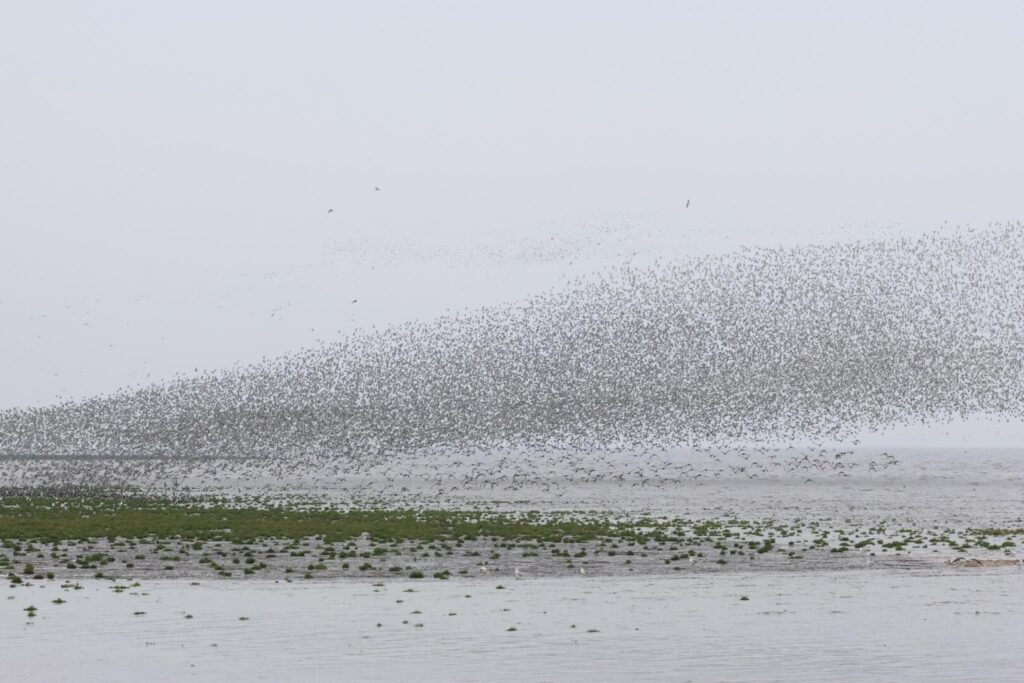
The Knot swirled out over the Wash and a huge wave, several 10s of thousands strong, came in low over our heads – all we could hear was the beating of their wings.
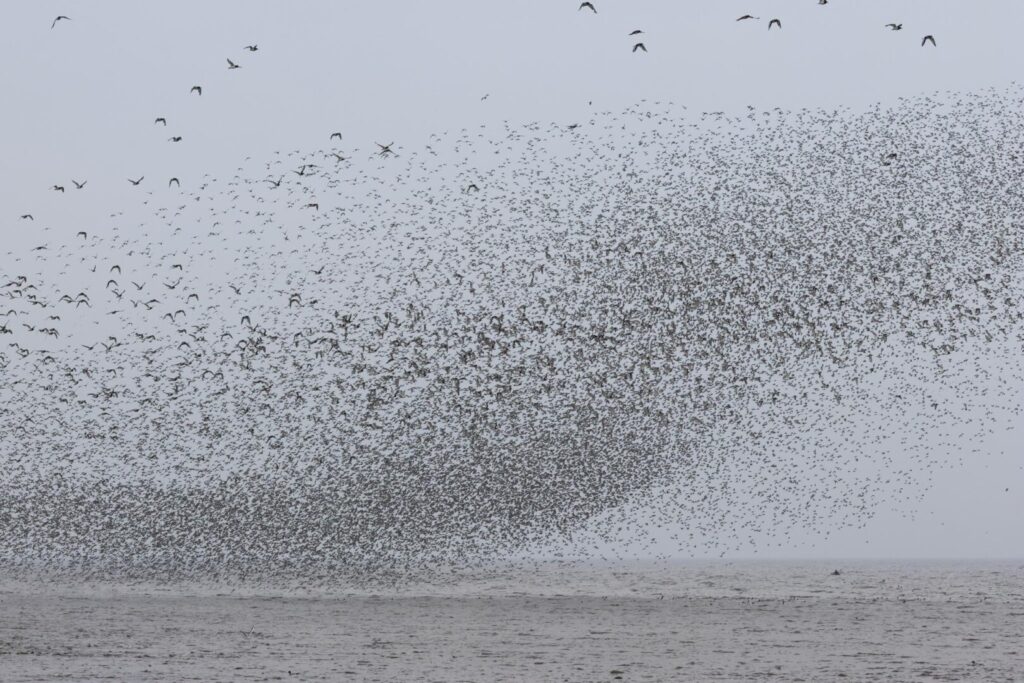
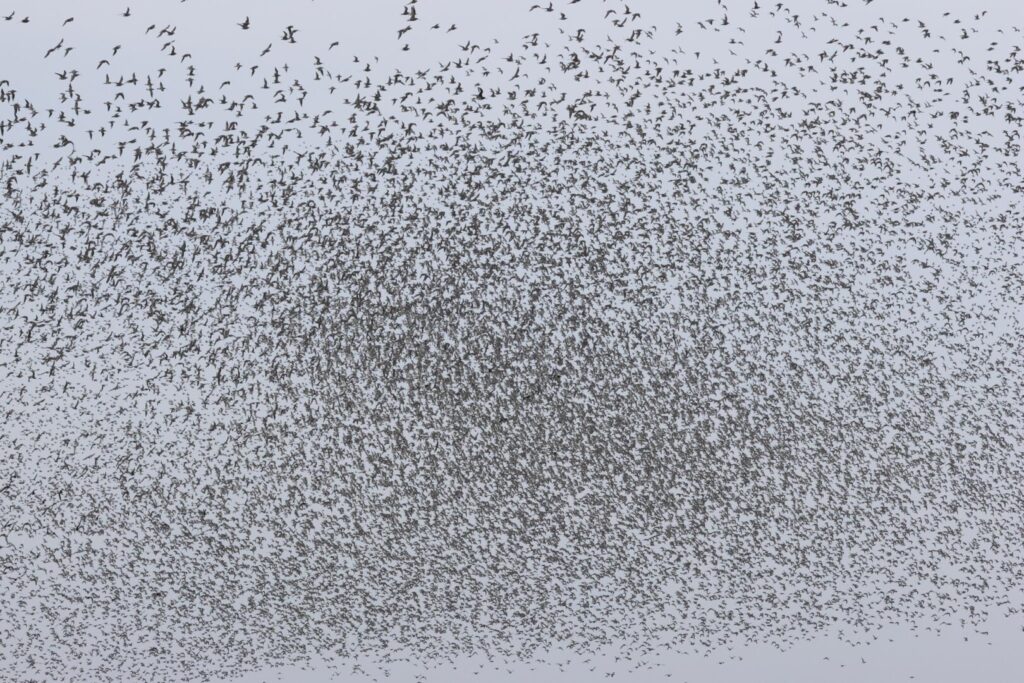
Some of the Knot tried to settle, but then they erupted again. This time we spotted the culprit as a Peregrine flew up between the panicking flocks. It stooped down back towards the saltmarsh and caught one, disappearing off inland with its prey in its talons.
Thousands of Knot were trying to come in to the Pit behind us, siphoning down. But they were very nervous and both the Knot and the Oystercatchers weren’t settling. They kept flying up again.

The airspace over the Pit was congested and thousands and thousands of the Knot started to tower up higher and higher into the sky. They probably didn’t realise the Peregrine had already caught its breakfast, but the best way to escape is to gain the advantage of height. We watched mesmerised as the waves of Knot at different altitudes criss-crossed above our heads. The higher flocks started to form into ‘v’s. They were preparing to see out the high tide high in the sky today.

Still more thousands of Knot settled back down in the last remaining corner of the mud again. Not for long though! They were still very nervous and this time were flushed by a Marsh Harrier.
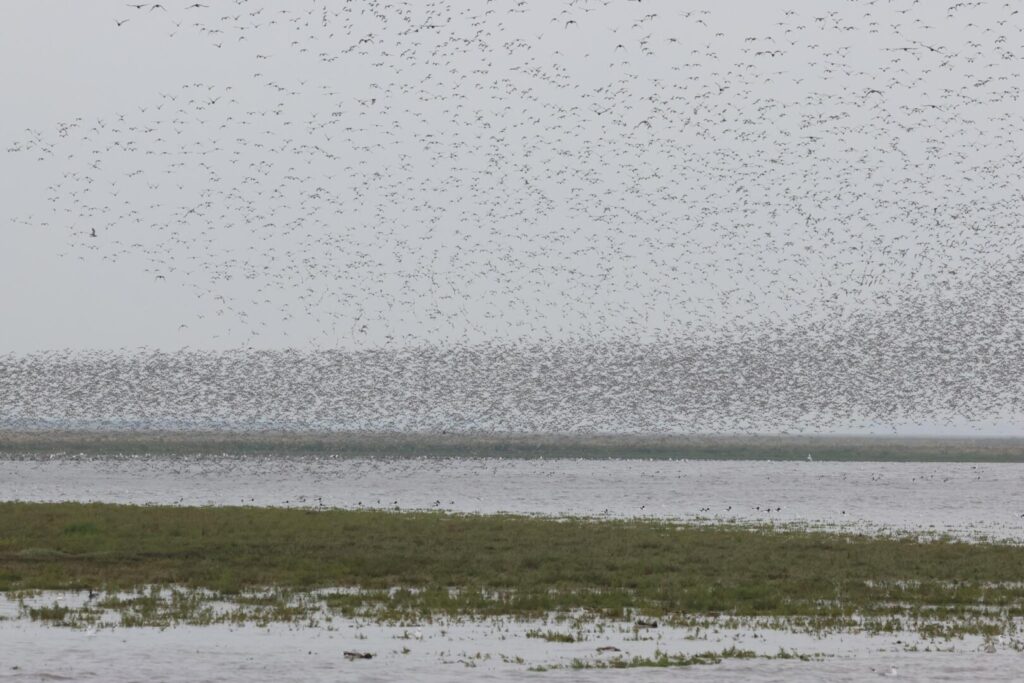
The water quickly covered the last remaining corner of the mud and the Knot had nowhere to go now. We stood and watched them. Some were still dropping down into the pits but more and more went out over the Wash and high into the sky.
Eventually the action subsided. A lone juvenile Dunlin appeared on the shore and picked its way along the gravel right next to us.

We made our way down to South Screen. There were lots of Knot and Black-tailed Godwits on the islands in front. Several Bar-tailed Godwits were in with them too, and we had nice views of the two godwit species roosting side by side through the scope.

The Knot were packed in tight, shoulder to shoulder. Most are in grey non-breeding plumage now, but we could see one or two with variable amounts of orange on their underparts still and darker blackish upperparts.
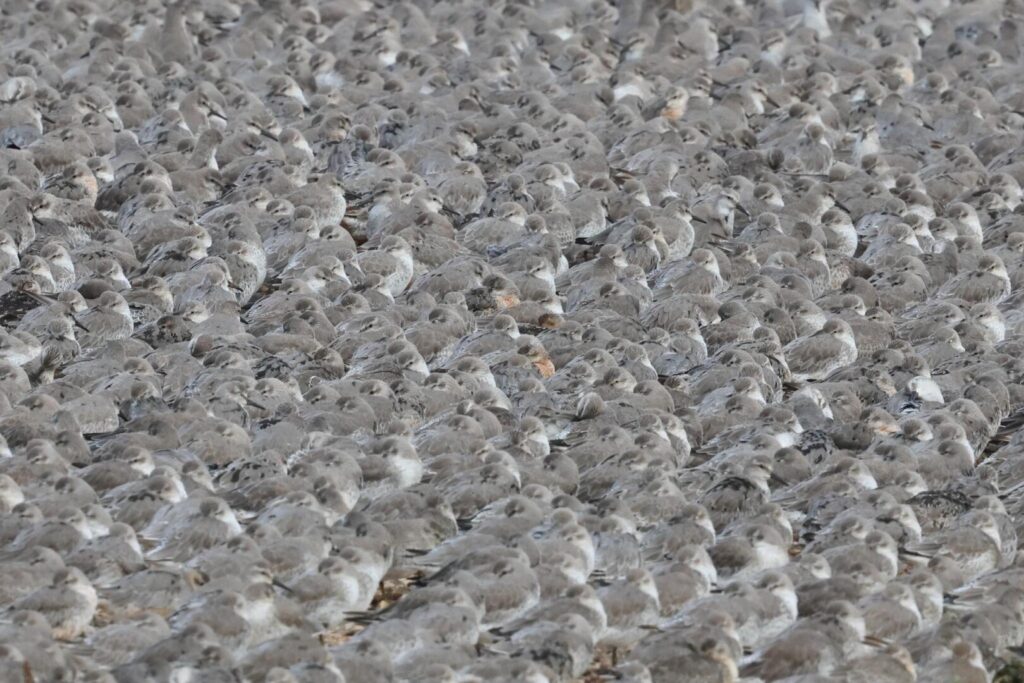
The shingle banks either side were liberally covered with Oystercatchers now. A large group of Common Redshank was gathered on the edge of the water below us.
We continued on down to the big hide, Knot’s Landing. There were nice close views of all the Knot and Black-tailed Godwits, although it is next-to impossible to use a scope through the one way glass. A single Lapwing walking around on one of the islands was moving the flocks around.
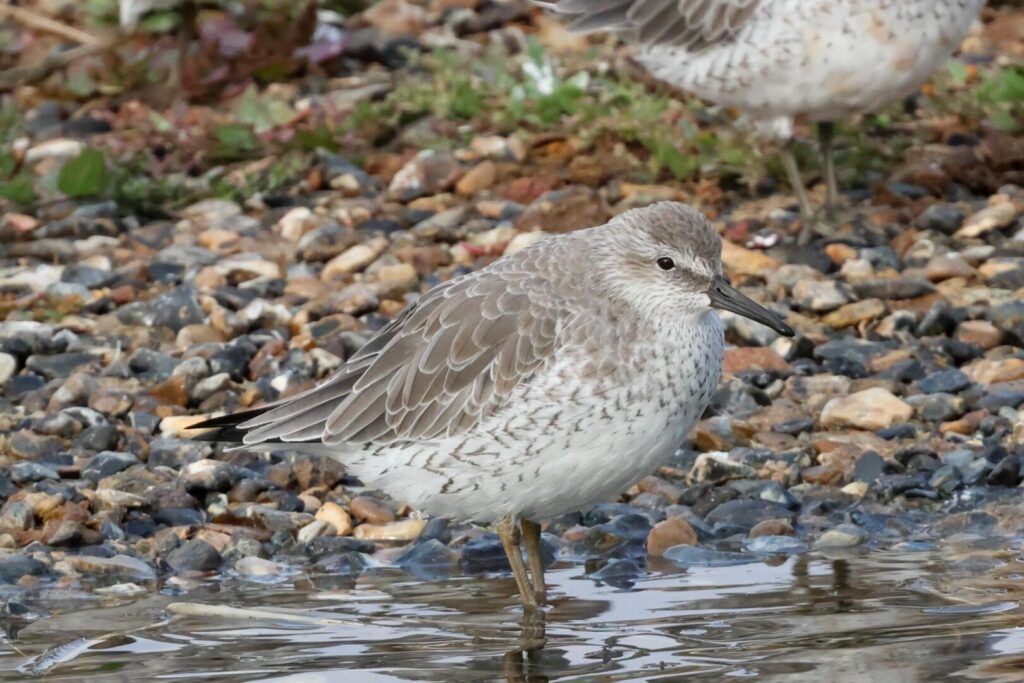
A Common Sandpiper picked its way along the short right in front of the hide.
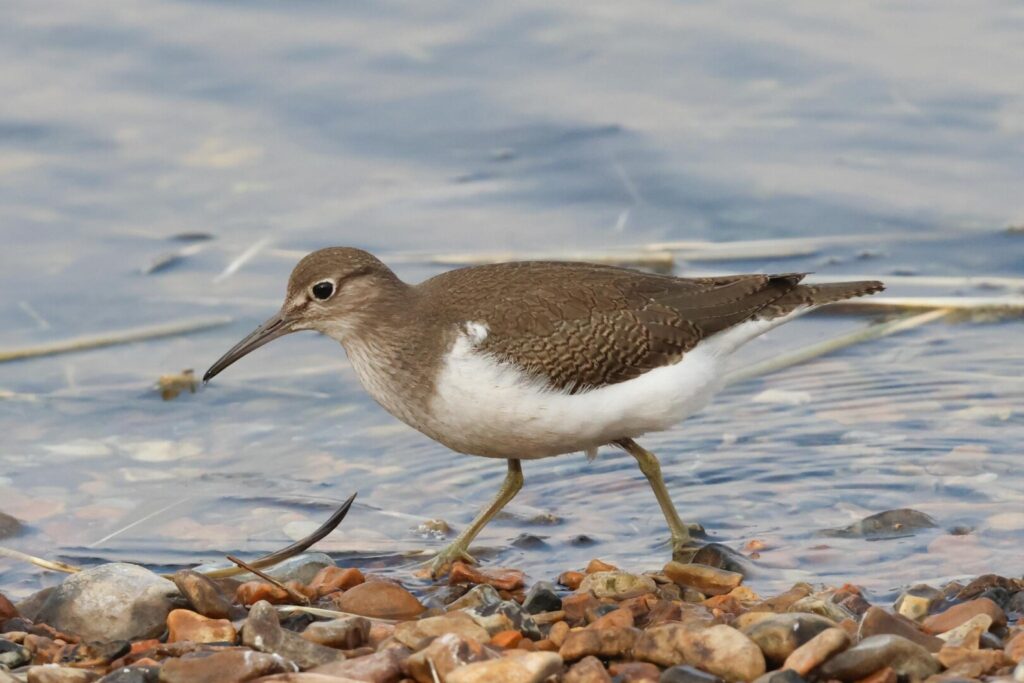
Shore Hide had emptied out considerably, so we decided to walk back round. A couple of lines of Knot flew out already, but there was nowhere for them to land yet. They joined a large flock which was circling out over the Wash waiting for the mud to reappear.
There was plenty of room now in the hide. About a dozen Spoonbills were roosting out in the middle, on the partly submerged concrete blocks. Some were even awake! There were several Spotted Redshanks and a couple of Common Redshanks on the rocks too, although they were harder to count today with all the Spoonbills in the way!
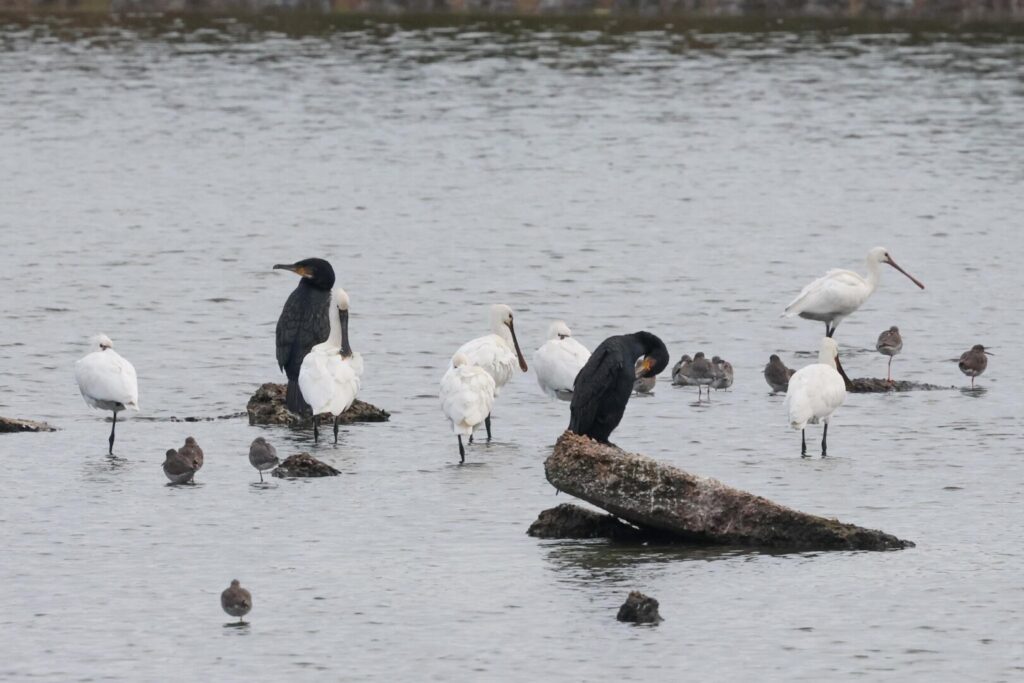
Lots of Knot were packed onto the two islands further on the pit. Something set the Knot on the further island moving and we watched the ripple flow through the flock, as they moved left and right, like someone was stirring them.
A single Pink-footed Goose swam across the Pit with two Greylags. On closer inspection we could see that it had damaged wings – presumably it had been shot and winged last year and spent the summer here with the ‘locals’. A lone leucistic Oystercatcher stood out in the middle of its normally coloured brethren further down.
Some of the Knot were starting to fly back out, so we headed back to the edge of the Wash. The mud was just starting to reappear and the first birds were landing back down out in the bay in the edge of the saltmarsh.
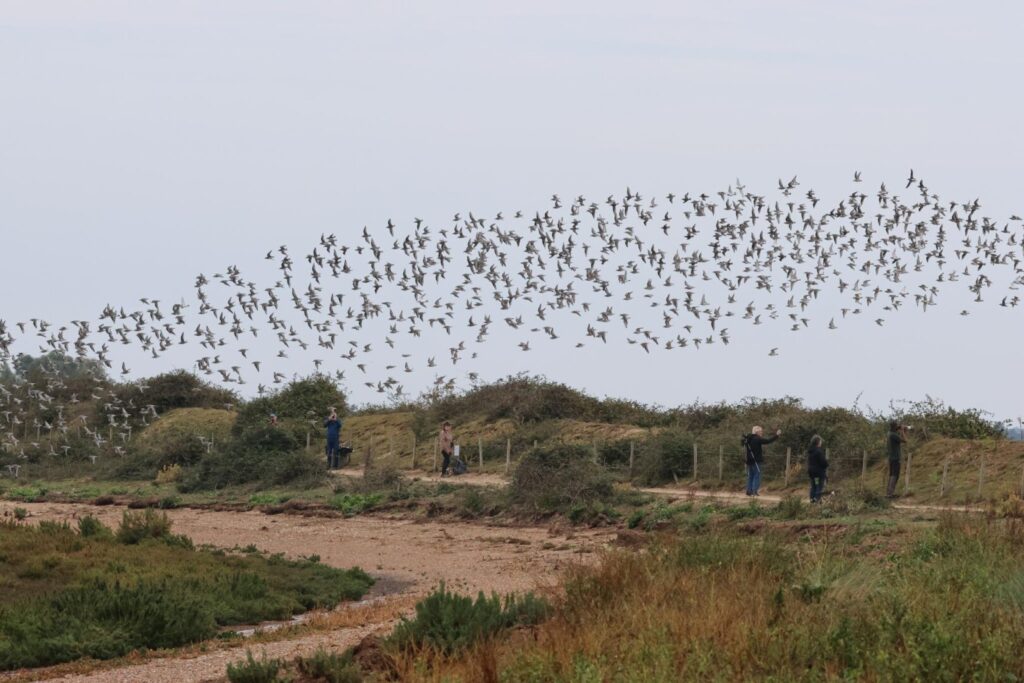
As we stood and watched, a succession of lines of Knot started to fly up out of the Pit behind us. Some came up over the bank further up, dropping straight back down again, and low out over the water. We watched them dinking from side to side as they headed over to join the others.
More flocks of Knot came up directly behind us. We could hear the noise as they took off and turned to see them heading straight for us. They came directly over our heads with a whoosh. The Oystercatchers started to fly up in big groups too and back out to the mud, piping noisily again.

Something spooked the Knot and they flew up, twisting and turning in a long ribbon wave out over the water. It was a false alarm this time and they turned and quickly resettled.

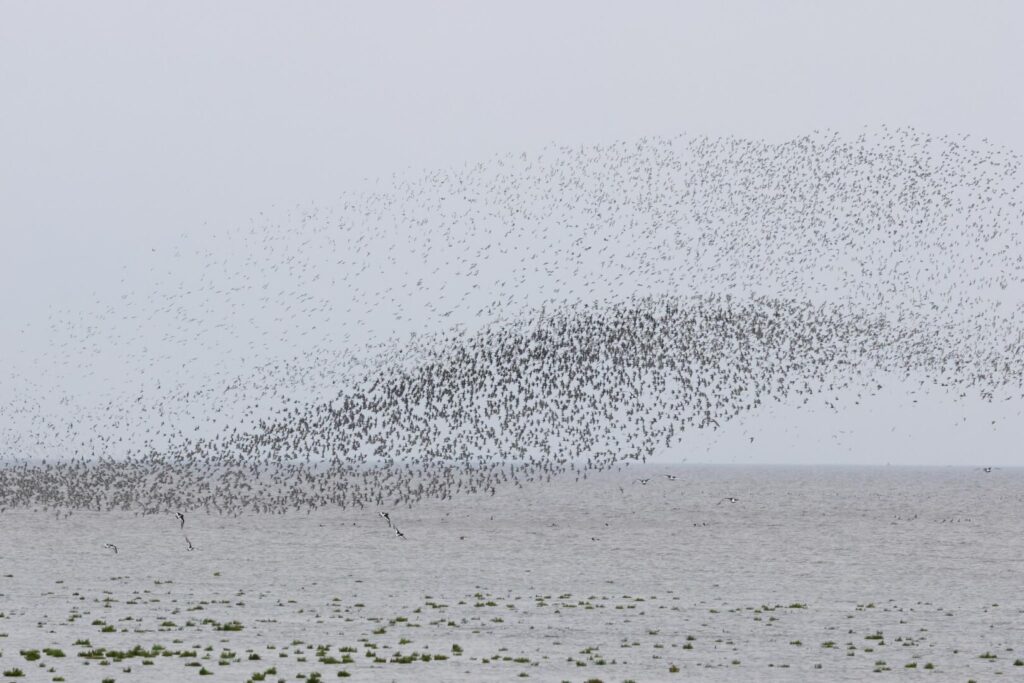
As more and more mud appeared, we scanned to see what we could find. The Curlews and Bar-tailed Godwits had reappeared from where they had been roosting on the saltmarsh. Scanning through, we found several Grey Plovers now too, three still in breeding plumage, still sporting their black faces and bellies.
Lots of Sanderling and Ringer Plover flew in from where they had been roosting, further up along the beach. Three Sandwich Terns appeared, preening out on the mud.
Everything seemed to settle down now, as the tide rapidly receded. We started to make our way back, stopping briefly to watch the Sea Aster Bees buzzing around their holes in the walls of the entrances to the rabbit burrows.
We made our way round to Titchwell next, taking the rather circuitous inland route to avoid the chaos of the temporary traffic lights on the main road at Heacham. The roads inland were coated in huge coveys of Red-legged Partridges which were reluctant to leave the middle of the tarmac. They have been released in enormous quantities here to be shot, though they are so tame you probably don’t need a gun!
When we got to Titchwell, it was time for lunch. The tame Blackbird and Robin were hanging around the tables in the picnic area again, hoping for crumbs.
After lunch, we headed out for a quick look at the Freshmarsh. It was rather grey now and threatening to rain. As we passed the reedbed pool, a Great White Egret was patrolling the edge of the reeds. A couple of groups of Pink-footed Geese came up from the back of the Freshmarsh and flew off east.
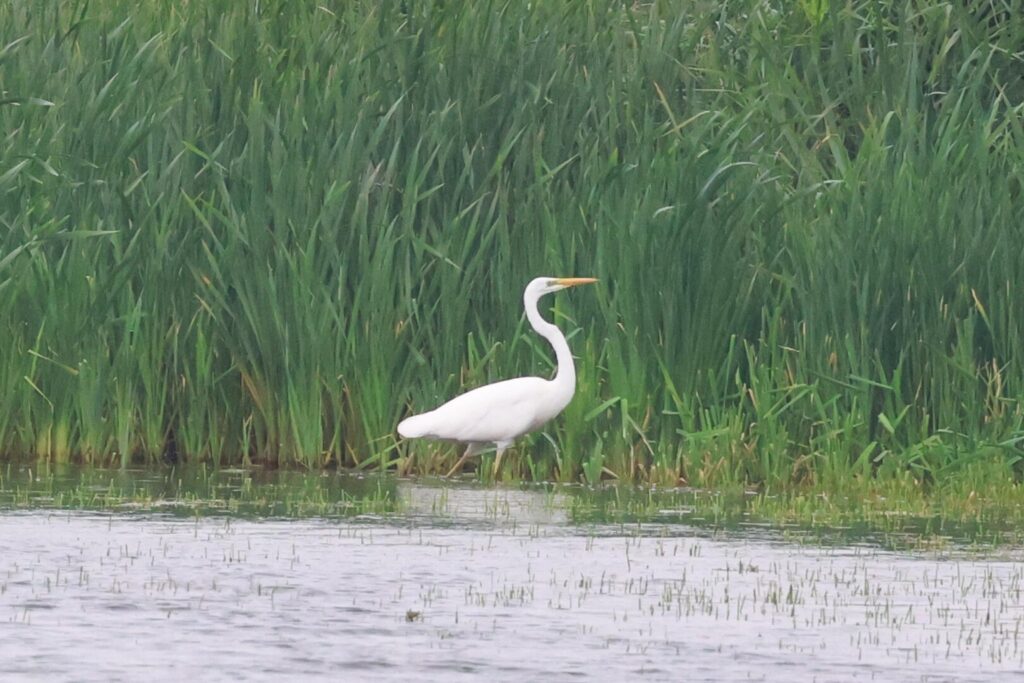
Everything erupted from the Freshmarsh and swirled around overhead. Then a Sparrowhawk appeared over the path and flew off out over the saltmarsh. There didn’t seem to be many waders left in front of Island Hide when we got up to the far end of the reedbed.
We thought we would have a quick look for the Little Stint on the next compartment up while it was dry but before we could get there it started to rain. The Little Stint flew off over the bund as we walked up and disappeared round behind one of the islands behind us. The escaped Black-winged Stilt was still here though, walking around in the shallow water, showing off its long bubblegum-pink legs.
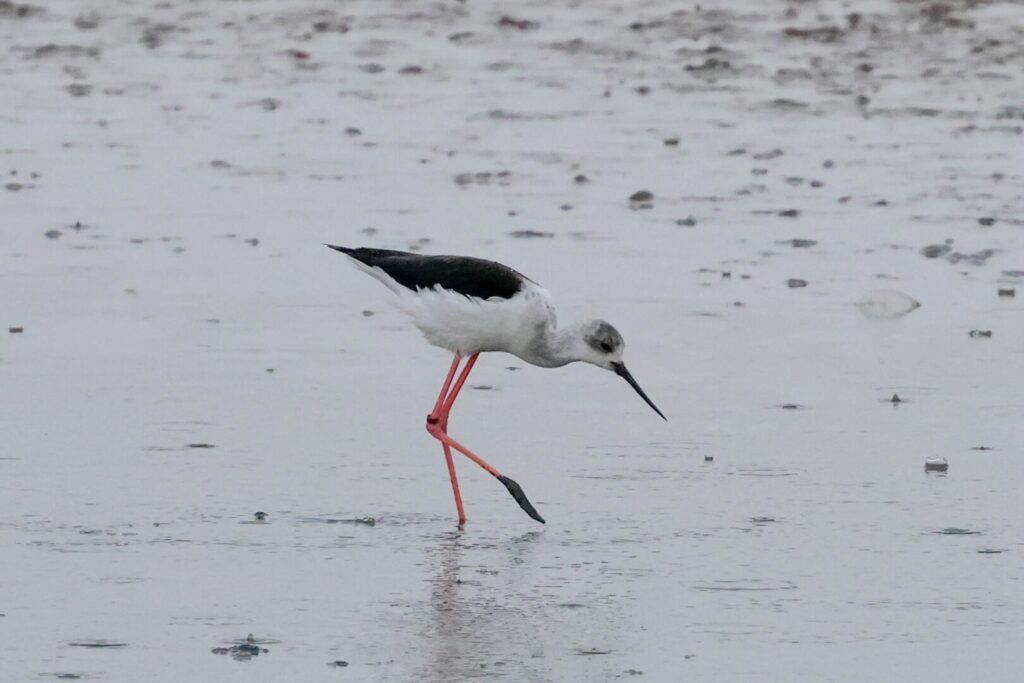
The elusive American Golden Plover had apparently put in another brief visit to the Freshmarsh late morning but had once again flown off. While we were on the West Bank, a succession of lines of Golden Plover flew in from Thornham Harbour. Unfortunately most continued straight on and over the far bank towards Brancaster. A few seemed to land over on the far compartment.
We hurried round to Parrinder Hide to get out of the rain. There were three Golden Plover on the back edge of the island in front of the hide, which we got in the scope. A few more appeared from behind the grassy mound a bit further over, including a couple still sporting the remnants of their black bellies. Another slightly larger group was on the island over the far side of the back compartment, but we couldn’t see anything different in with them. Most of the Golden Plover hadn’t dropped in though.
The Black-winged Stilt was still walking around in the shallow water over by the main path, so we got that in the scope for a better look.
There were lots of geese loafing around on the islands, mostly Greylags. Two white, formerly domesticated ones were in with them, as was the usual Greylag x Canada Goose hybrid. A White-fronted Goose had been reported here earlier, but all we could find now was a rather odd-looking Greylag with a white-forehead. There were still a few Pink-footed Geese left but they were over towards the back of the eastern compartment.
The rain eventually eased, so we headed back out to see if we could find the Little Stint again. We stood on the bank and scanned the two western compartments. There were lots of Ruff, but they were roosting towards the back with the Black-tailed Godwits. A Common Snipe was busy preening on the edge of the closest island, between the Lapwing, so we got that in the scope for a closer look. A Lancaster bomber flew past – not the type of bird we were really looking for!
Looking over the exposed mud again, now we found the Little Stint. Through the scope, we could see just how small it was, white below with a short black bill and bright pale tramlines on its mantle. A fresh juvenile, they have been in rather shorter supply than normal this year – perhaps a consequence of a poor breeding season up in northern Scandinavia and north-west Russia.
A nice bird to end a spectacular Wader Spectacular today. Unfortunately we were now out of time, as we had to be back early today. It had been a great three days birding, with some exciting autumn migrants.
If you enjoyed reading about what we got up to and would like to join us on one of our forthcoming tours, you can see what we have planned on our Tours page here. We will be adding dates for 2025 Wader Spectaculars shortly – watch this space!
















